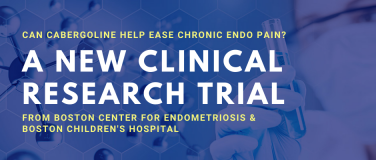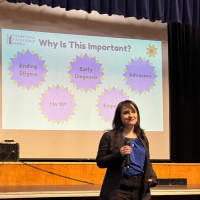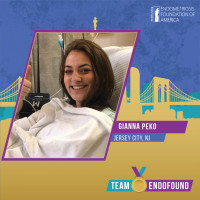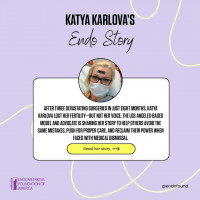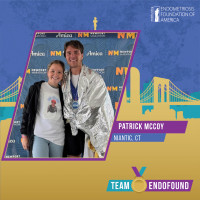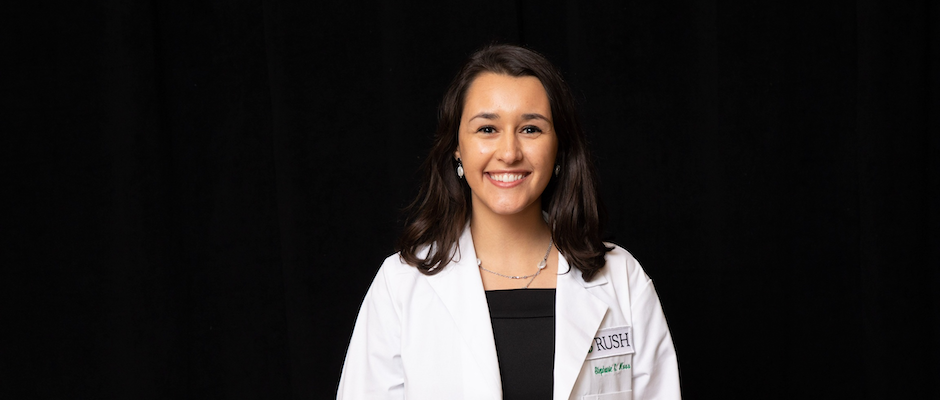
Stephanie Moss has now translated her essay into Spanish, to ensure that her story is more accessible. Click here for the Spanish translation.
Even though I have experienced abdominal and pelvic pain since puberty, I have visited multiple physicians who were unable to properly diagnose me. My experience was a mix of medical gaslighting, misdiagnosis, and not taking me seriously for being a young Latina with minimal family support. It wasn’t until I became a second year medical student that I acquired the knowledge and medical advantage that allowed me to stand up for my needs and get properly diagnosed through specialized medical care. My unique position as a medical student was a privilege that allowed me to advocate for myself in a way I had never had the confidence to do before.
My past involves a complex childhood trauma history with racial discrimination whichprevented me from getting the resources and education to be previously diagnosed and cared for. In the fall of 2020, I was finally able to be properly diagnosed with endometriosis with tubal occlusion through laparoscopic surgery. Additionally, I am currently undergoing IVF follicular stimulation with the goal to freeze embryos for when my husband and I complete our residency trainings in seven years.
Once I was diagnosed with endometriosis, I started reading studies about how adverse childhood experiences (ACEs) impacted my physical health. As Harris et al. confirmed in a study conducted in the early 2000s and published in 2018, the childhood trauma that one experiences in their early life is associated with an increased risk of endometriosis.
In addition to synthesizing and sharing my journey on social media and my blog, I am in the process of writing a book about how childhood trauma has a direct impact on mental health, physical health, and relationships. Here is a short preview of the chapter regarding my journey trying to uncover a medical diagnosis for my pelvic and abdominal pain.
First Signs of Pain
In middle school, my passion for science led me to do my own research at our local library on the pain that came with my period. After a few weeks of casually snooping, I found the shelf with books about teenage bodies and puberty. I would nonchalantly grab one of the books and rest it open on a separate book shelf. As I pretended to be looking at fiction books, I quickly absorbed all the information I could on puberty. I never had the chance to fully read each book, but for many months I skimmed them from a back corner of the library’s teenage section. Whenever I heard my parents’ voice I would jump up from the ground and pretend to be looking at the spines of the various other library books.
Unfortunately, my self-researched knowledge was never enough to answer all my questions. Naturally, my friends were the next source of information. One day my middle school friends and I were chatting about all of our menstrual pains. Everyone seemed to have different levels of pain and for different numbers of days. In our middle school health class, we were told that premenstrual syndrome (PMS) and the start of becoming a woman was supposed to be very painful. This concept of pain was similarly normalized by my peers. One of my friends expressed that she had such bad PMS abdominal pain that her mother allowed her to stay home at least one day each month. I was very jealous of her that she could ditch school because of pain, even though we were all expected to deal with pain as women. I felt that my level of pain was similar to hers, but I rationalized that I must be stronger because I could live through the pain.
My PMS never stopped me from going to school or participating in my karate workouts. I remember reading that pain could be overcome by exercising and pushing through it. Therefore, I became very involved in my martial arts training. Even though our instructors tried to mentally break us through hours of fitness testing, my hardened mindset of not letting physical pain affect my mental state allowed me to thrive under pressure.
Eventually, my abdominal and pelvic pain caught up to me. On my 15th birthday, while also testing for one of my upper black belt ranks, I experienced severe pelvic pain which I could no longer ignore. When I began to feel the pain, I instinctively swallowed some pain medicine before jumping out on the karate floor to spar. Not too long after, my partner and I started kicking each other and I collapsed on the floor with tears running down my face. Everyone circled around me, but I kept repeating that I was fine. One of my adult mentors said I might have appendicitis, so I was rushed to the hospital. After some pain medication, blood tests, and a CT scan, I was sent home with a possible diagnosis of an “ovarian cyst.”
These episodes of intense pain continued every couple months, mostly in my lower right abdominal cavity. During severe episodes I sometimes called the nursing hotline to ask if I should go to the hospital. The nurse or physician on call always resorted back to it most likely being an ovarian cyst or PMS, and recommended I take pain medication and use a heating pad.
Painful periods, medically diagnosed as dysmenorrhea, is actually very common; 50% to 90% of reproductive aged women experience pain at some point (McKenna, K. Fogleman, C. 2021).However, even though abdominal pain is a common problem, doctors are required to confirm that the pain is not severe nor caused by another medical condition. Nonsteroidal anti-inflammatory drugs (like ibuprofen) and hormonal contraceptives (like birth control pills, shots, IUD, or implants) are first-line medical treatments for pelvic pain (McKenna, K. Fogleman, C. 2021). Unfortunately, since my parent removed me from the doctor’s office after the doctor mentioned birth control pills, I did not have the opportunity to explore other possibilities or treatment for my pain.
Managing One’s Healthcare
When I became a legal adult I finally had the opportunity to take charge of my own healthcare. Once I turned 18, I used the money from my martial arts instructor job to pay for doctor’s visits, copays, and medications. This included being able to visit a doctor who prescribed me birth control pills for my pain. When I began college, I continued to explore the cause of my continued pelvic and abdominal pain by making appointments with various doctors. One physician suggested it was probably my bowels getting stuck, which was normal for “skinny girls like me.” Another doctor told me it was constipation, and told me to eat more fiber. This led me to set up an appointment with a gastroenterologist (an intestine and bowel specialist). After hearing my symptoms, the specialist scheduled me for a colonoscopy to check my large intestine for any physical manifestations that could explain my pain.
About a week before my colonoscopy appointment, my abdominal pain suddenly manifested into non-stop vomiting. I was rushed to the hospital after my vomit turned bright red with blood. The vomiting was quickly aborted with medication and I was given fluids via an IV to combat dehydration. After telling the emergency room physician I had a colonoscopy coming up, it was decided they would also perform an endoscopy to look into my stomach during the upcoming appointment. This meant that under anesthesia I would have a camera go down my throat to look at my stomach and small intestines. Then, for the colonoscopy, they would insert another camera through the other end to look into my large intestine. Thankfully, I was going to be asleep for all of this!
The colonoscopy did not find anything out of the ordinary. However, the endoscopy discovered six ulcers throughout my lower stomach and the first part of my small intestine (the duodenum). The doctor was beyond himself, and he said he had never seen so many gastric ulcers. Additionally, I did not meet the two most common causes of the ulcers. The biopsy of the ulcer tissue came back negative for H. Pylori, a bacteria which is one of the most common causes of ulcers. I also didn’t consume a lot of ibuprofen, another common cause of ulcers. I usually took acetaminophen for my pain. Therefore, the last possible explanation was that my ulcers were caused by stress.
In the past, doctors had explained away my stomach, abdominal, pelvic pain as a manifestation of stress, because I was a pre-medical student, which apparently made me “supposed to be stressed.” However, ulcers manifesting from stress did not make much sense to me because I didn’t feel overwhelmed by stress. In fact, I felt I was the least stressed I had ever been in my life, because I was in college and had finally moved out of my toxic home environment.
Years after the endoscopy, I began to make the connection of how I developed those ulcers. Living for 18 years in my household environment with frequent abuse and neglect resulted in a chronic level of stress that then manifested in my body as a physical illness. In fact, there are many studies that demonstrate the impact of chronic stress on the body. The constant release of cortisol, a stress hormone, leads to a decrease in the body’s protection against foreign invaders or a mishandling of the immune response against its own body, and a development of an auto-immune type of disease.
That being said, the discovery that I had gastric and duodenal ulcers would just be the start of my medical conditions as a trauma survivor. However, in order to uncover them I would need to surpass the pervasive medical gaslighting and uneducated medical community regarding women’s pelvic and sexual pain.
Medical Gaslighting
In college, I received a pelvic and intravaginal ultrasound to rule out different medical conditions. I remember holding back tears as the ultrasound tech shoved the probe into me. She told me to hold still, but all I could do was tell her it really hurt. She chuckled at me and joked that I must be a virgin. I was not.
After a couple years of struggling with different hormone doses in birth control pills, I decided to ask my OBGYN for an IUD. I was not prepared for the excruciating pain. I squeezed my now-husband’s hand so hard his hand turned white. I felt my gown become soaked in my tears as the doctor opened my cervix a couple centimeters to place the IUD inside my uterus. After the procedure, the doctor suggested that next time I should take some ibuprofen before I come in.
Over and over, medical professionals discounted my pain or suffering as either normal or they assumed I was exaggerating. I couldn’t help but think they believed I was just a young Hispanic girl who was crying for attention. This substandard care is an example of racial discrimination which is unfortunately prominent across the health care field. Racism is in fact a “fundamental determinant of health” by creating greater social inequality in how medical professionals interact with patients (Prather et. Al, 2018). The racist negative stereotype of women of color complaining, being “aggressive,” or “angry” frequently prevents medical providers from taking them seriously and addressing their healthcare concerns (Prather et. Al, 2018). These examples of discounting my pain were also examples of medical gaslighting, a term used to describe when medical providers treat their patients like their suffering does not matter or is not as bad as they say it is. However, I had no conception of the term “gaslighting,” nor that it was an inappropriate and disrespectful way to communicate.
In fact, this manner of discounting my experience was just the way my family communicated in the household, so I had no idea that I didn’t deserve to be treated like this. In my house, we were not allowed to feel or express emotions without the permission of my parent. They were in charge of how the household functioned and dictated the emotional atmosphere. Therefore, I learned it was not safe to express my feelings, including any pain I had. Only my parent was allowed to have medical conditions and be in pain. Our pain was not “bad enough,” and they sometimes suggested we were making it up to not go to school. To summarize, I learned to not complain of the pain I was experiencing.
The next time I visited the OBGYN, I was shocked that he remembered that I had pain the last time during the IUD insertion. Therefore, in addition to having me take pain medication, he gave me a local anesthetic while removing the current IUD and placing a new one. After telling him that this was the last time I would see him, because I was moving out of state for medical school, he suggested that I look into a rare condition called endometriosis. He said that the only way to properly diagnose it was through undergoing surgery. Although, as he said, I was “too young” for surgery, I shouldn’t worry about that until after my medical training. Since I trusted this kind and wise doctor, who had also delivered me at birth, I put the possible diagnosis in my back pocket to explore in the future.
The Privilege of Being a Medical Student
Medical school provided me with an extraordinary variety of medical and academic resources and mentors. One of the most significant resources was the Cadillac health insurance plan. This meant that as medical students of a major university system, we had access to top notch physicians and specialists which we could use to treat our own conditions. This access empowered me to reach out to medical care professionals who I had never been able to access before.
The second year of medical school started with the sex and reproduction block. That entire block was a huge blur as I found myself checking off all my symptoms in various female reproductive disorders. Once again, doctors told me it was just my anxiety and “medical student brain” freaking out. This distrust for my own experience led me to once again feel alone and ignored. However, for the first time, I had the tools in front of me to diagnose and treat my own pain.
For the rest of that educational block, I spent every spare moment reading up and learning about every single female medical condition. Could it be PCOS (polycystic ovary syndrome)? What about fibroids? Or could it be endometriosis? This mental turmoil significantly impacted my academics. I became so obsessed with trying to diagnose myself that I had failed to focus on my studies. Imposter syndrome set in hard, and I wondered if I was even cut out for a medical career.
Sometime during this block, I met with an OB/GYN who specializes in pelvic pain disorders including endometriosis. She was not a physician directly a part of my university, but I had found her while on a research rampage of the types of surgical technologies used to diagnose abdominal disorders. In preparation for my exam I had written out a long list of symptoms which I had experienced consistently throughout my life. I then had another list of endometriosis symptoms and cross checked all the symptoms I experienced. In addition to the cyclical dysmenorrhea and pelvic pain, I frequently had pain going to the bathroom—both to urinate and during a bowel movement. Additionally, a couple times I had tried wearing tampons during my menstrual cycle and they were always very uncomfortable and a little painful, so I rarely used them. Then in medical school I had learned in our lectures that sex was NOT supposed to be painful. That new knowledge was mind blowing. I had incorrectly thought that sometimes pain during sex was just a part of being a cis-heterosexual-women.
After going through my long list of symptoms and pain journey, the surgeon agreed that my ten-year long pelvic and abdominal pain was most likely explained by endometriosis. She then proceeded to schedule me with a laparoscopic surgery the very next month. I was over the moon! I didn’t even listen to her as she described the possible side effects or the specifics of the procedure. All I could think of was, “finally someone believes me!”
The Surgery & ACEs
In November 2020, I was able to have a laparoscopic surgery with the famous DaVinci machine. It was such expensive equipment that they only had three in all of Chicago, and my medical school hospital happened to have two of them!
This was my first surgery and first time under anesthesia. I couldn’t possibly contain my excitement. Talking with one of the upper year medical students was the last thing I remember before waking up. Apparently, the procedure was over and it took much longer than expected. The pain—so much pain. The nurse gave me another painkiller. I went back and forth between begging the nurse to let me see my husband and asking her to give me more pain medicine. She told me he couldn’t come in until I had the pain managed and until I went to pee. “Ha,” I remember thinking, “you want me to stand up and walk to the bathroom? You have to be kidding me!” Eventually I mustered up the energy, bit into my gown, and wobbled to the toilet. Blood everywhere. I wobbled out of the bathroom to tell the nurse about the blood, which she said was normal.
I almost fainted from the pain as I sat back down into the post-op chair. How in the world was I going to make it home? When my husband came back to see me, he told me the results but I couldn’t really focus on what he was saying; all I heard was they found endometriosis and we would talk more about it tomorrow. It was time to go home and recuperate. Normally I would have fought him because he wasn’t telling me everything, but all I wanted to do was to get out of the hospital. The nurse asked me if I could walk to the car or if I needed a wheelchair. The words were out of my mouth before I could fight my own subconsciousness: “wheelchair.”
The next morning, I begged my husband to tell me what the surgeon had found. He showed me the pictures that were taken. The semi-good news was that the surgeon had, in fact, found a lot of possible endometrial tissue on my abdominal wall, lesions she was able to excise. She also found a small hole or “defect” in my pouch of Douglas, which is a tissue pouch behind my uterus separating it from my large intestine. Additionally, my ovaries looked young and healthy with no chocolate cysts, which are blood-filled cysts and a common complication in endometriosis. However, there was bad news: the surgeon pushed fluid multiple times into my fallopian tubes and could not get the fluid to come out the other end of the tubes. This meant that the tubes were clogged, most likely from endometrial scar tissue.
I felt myself freeze and dissociate as my mind raced ahead and realized the meaning of his words. Clogged fallopian tubes meant I could not have kids naturally in the future… My trauma response brain, prone to intellectualizing, began to work overdrive instead of expressing any emotions. My surgeon had mentioned that when we were ready, we could reach out to a fertility doctor who specialized in women who had similar types of infertility. Immediately I looked her up and scheduled an appointment for the near future.
While doing academic research on endometriosis, I found an interesting article published in 2018 by Harris et al. about an association between childhood physical and/or sexual abuse and later-diagnosed endometriosis through laparoscopy. Between 1999 and 2001, through the Nurses’ Health Study II cohort, a survey was mailed to over 90,000 individuals who were asked about their exposure to violence, of which over 68,000 returned the questionnaire. In a 24 year follow up, over 3,300 of those individuals were later diagnosed with endometriosis. This study found that those with a history of severe physical and/or severe sexual abuse had an increased relative risk of having confirmed endometriosis than those who did not report abuse. Additionally, those with severe chronic multiple types of abuse had a 79% increased risk of laparoscopic confirmed endometriosis (Harris et al, 2018). The authors write, “Severity, chronicity and accumulation of types of abuse were associated with greater risk. Understanding the mechanisms underlying these relations may better define the biological impacts of abuse and the related pathophysiology of endometriosis” (Harris et al, 2018).
Connection as a Medical Provider
To conclude, I have been focusing some of my advocacy work in sharing my experience with my medical peers and encouraging them to ask each patient about their trauma and pain history. As Kulingowska et al stated in a 2005 paper, “gynecologic causes are frequently overlooked and under-diagnosed, resulting in inappropriate referral and inadequate treatment.” Therefore, providers should ask their patient if they have a history of trauma or pain before performing sensitive pelvic exams. It will not just help the patient feel more physically comfortable during the exam, but could be the foundation to uncovering medical conditions. Pain is not normal; pain is the body telling the brain that something is not right. As medical professionals we need to listen to our patients with more nuanced compassion and understanding, to remember that there is a reason someone is in pain, and we just have to take the time to figure out why. As Dr. Arrielle Schwartz and Dr. Stephen Porges has stated, “a trauma history is a pre-existing condition…. because it tells the body to be in a chronic state of stress” and can lead to chronic health conditions.
Sources:
Harris, H. Wieser, F. Vitonis, A. Rich-Edwards, J. Boynton-Jarrett, R. Bertone-Johnson, E. Missmer, S. (2018) Early life abuse and risk of endometriosis, Human Reproduction, Volume 33, Issue 9, Pages 1657–1668. https://doi.org/10.1093/humrep/dey248
Kuligowska, E. Deeds, L. Lu, K. (2005). Pelvic pain: overlooked and underdiagnosed gynecologic conditions. Radiographics. Jan-Feb;25(1):3-20. doi: 10.1148/rg.251045511. PMID: 15653583. https://doi.org/10.1148/rg.251045511
McKenna, K. Fogleman, C. (2021). Dysmenorrhea. American family physician, 104(2), 164–170. PMID: 34383437. https://pubmed.ncbi.nlm.nih.gov/34383437/
Prather, C. Fuller, TR. Jeffries IV, WL. Marshall, KJ. Howell, AV. Belyue-Umole, A. King, W. (2018). Racism, African American women, and their sexual and reproductive health: a review of historical and contemporary evidence and implications for health equity, Health Equity 2:1, 249–259, DOI: 10.1089/heq.2017.0045. https://doi.org/10.1089/heq.2017.0045



